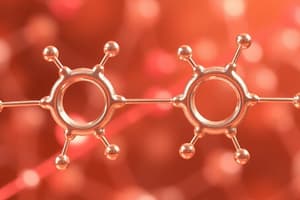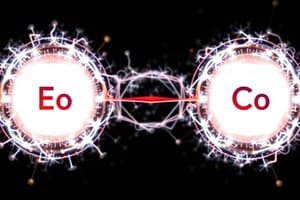Podcast
Questions and Answers
Is SF6 an ionic, polar, or nonpolar compound?
Is SF6 an ionic, polar, or nonpolar compound?
- Ionic
- Nonpolar (correct)
- Polar
Using the electronegativity values, the B-H bonds in BH3 are __________.
Using the electronegativity values, the B-H bonds in BH3 are __________.
Nonpolar covalent
Is NH3 an ionic, polar, or nonpolar compound?
Is NH3 an ionic, polar, or nonpolar compound?
- Ionic
- Polar (correct)
- Nonpolar
The bonding predicted by electronegativities in CsBr is __________.
The bonding predicted by electronegativities in CsBr is __________.
Identify the pair that lists the element with the higher electronegativity value written first.
Identify the pair that lists the element with the higher electronegativity value written first.
Which element has the smallest electronegativity?
Which element has the smallest electronegativity?
Using the electronegativity values, the Li-N bonds in Li3N are __________.
Using the electronegativity values, the Li-N bonds in Li3N are __________.
Identify the pair that lists the element with the lower electronegativity value written first.
Identify the pair that lists the element with the lower electronegativity value written first.
The polar molecule among the following is __________.
The polar molecule among the following is __________.
The polar molecule among the following is __________.
The polar molecule among the following is __________.
Which element has the greatest electronegativity?
Which element has the greatest electronegativity?
Which bond is the most polar?
Which bond is the most polar?
Which combination of elements will be most likely to form an ionic compound?
Which combination of elements will be most likely to form an ionic compound?
The bonding predicted by electronegativities in HCl is __________.
The bonding predicted by electronegativities in HCl is __________.
Which element will form the most polar bond with fluorine?
Which element will form the most polar bond with fluorine?
The nonpolar molecule among the following is __________.
The nonpolar molecule among the following is __________.
Using electronegativity values, the C-Cl bonds in CCl4 are __________.
Using electronegativity values, the C-Cl bonds in CCl4 are __________.
Is PF5 an ionic, polar, or nonpolar compound?
Is PF5 an ionic, polar, or nonpolar compound?
The bonding predicted by electronegativities in Cl2 is __________.
The bonding predicted by electronegativities in Cl2 is __________.
Is ClF3 an ionic, polar, or nonpolar compound?
Is ClF3 an ionic, polar, or nonpolar compound?
Is XeF4 an ionic, polar, or nonpolar compound?
Is XeF4 an ionic, polar, or nonpolar compound?
The polar molecule among the following is __________.
The polar molecule among the following is __________.
The nonpolar molecule among the following is __________.
The nonpolar molecule among the following is __________.
The bonding predicted by electronegativities in HCl is __________.
The bonding predicted by electronegativities in HCl is __________.
The nonpolar molecule among the following is __________.
The nonpolar molecule among the following is __________.
The bonding predicted by electronegativities in HBr is __________.
The bonding predicted by electronegativities in HBr is __________.
What are the general trends in electronegativity values?
What are the general trends in electronegativity values?
The bonding predicted by electronegativities in MgO is __________.
The bonding predicted by electronegativities in MgO is __________.
The nonpolar molecule among the following is __________.
The nonpolar molecule among the following is __________.
Flashcards
SF6
SF6
A nonpolar compound due to its symmetrical structure.
BH3 bonds
BH3 bonds
Considered nonpolar covalent, indicating equal sharing of electrons.
NH3
NH3
Identified as a polar compound because of its bent shape and electronegativity difference.
CsBr bonding
CsBr bonding
Signup and view all the flashcards
Electronegativity of C and Si
Electronegativity of C and Si
Signup and view all the flashcards
Gallium electronegativity
Gallium electronegativity
Signup and view all the flashcards
Li-N bonds in Li3N
Li-N bonds in Li3N
Signup and view all the flashcards
Electronegativity of P and S
Electronegativity of P and S
Signup and view all the flashcards
Polar C-N bond
Polar C-N bond
Signup and view all the flashcards
PCl3 polarity
PCl3 polarity
Signup and view all the flashcards
Greatest electronegativity
Greatest electronegativity
Signup and view all the flashcards
Most polar bond
Most polar bond
Signup and view all the flashcards
Ionic compound formation
Ionic compound formation
Signup and view all the flashcards
HCl bonding
HCl bonding
Signup and view all the flashcards
Most polar bond - Boron & Fluorine
Most polar bond - Boron & Fluorine
Signup and view all the flashcards
C2H4 polarity
C2H4 polarity
Signup and view all the flashcards
CCl4 molecule
CCl4 molecule
Signup and view all the flashcards
PF5 classification
PF5 classification
Signup and view all the flashcards
Water (H2O) polarity
Water (H2O) polarity
Signup and view all the flashcards
CO2 polarity
CO2 polarity
Signup and view all the flashcards
N2 polarity
N2 polarity
Signup and view all the flashcards
HBr bonding
HBr bonding
Signup and view all the flashcards
Electronegativity trend
Electronegativity trend
Signup and view all the flashcards
MgO bonding
MgO bonding
Signup and view all the flashcards
O-H bonds in water
O-H bonds in water
Signup and view all the flashcards
P-Cl bonds in PCl3
P-Cl bonds in PCl3
Signup and view all the flashcards
Study Notes
Electronegativity and Polarity
- SF6 is classified as a nonpolar compound due to its symmetric structure that balances dipoles.
- In BH3, the B-H bonds are considered nonpolar covalent, indicating equal sharing of electrons.
- NH3 (ammonia) is identified as a polar compound owing to its bent shape and electronegativity difference between N and H.
- CsBr exhibits ionic bonding, stemming from the significant electronegativity difference between cesium and bromine.
- The pair C and Si demonstrates higher electronegativity for carbon, which is critical for predicting bond characteristics.
- Gallium has the smallest electronegativity, impacting its reactivity and bonding behavior.
- The Li-N bonds in Li3N are classified as ionic, driven by the strong electronegativity difference between lithium and nitrogen.
- The pair P and S lists phosphorus first, indicating it has the lower electronegativity value relative to sulfur.
- The molecule N-C-CH3 (an amine) is identified as polar due to the presence of a polar C-N bond.
- PCl3 is also a polar molecule, attributed to its trigonal pyramidal geometry and electronegativity differences.
- Oxygen holds the title for the greatest electronegativity, making it highly reactive.
- The bond that is most polar is B-Cl, due to the significant electronegativity difference.
- Ionic compounds are typically formed between a metal and a nonmetal, reflecting strong differences in electronegativity.
- In HCl, the bonding is characterized as polar covalent, highlighting partial charges across the molecule.
- Boron will form the most polar bond with fluorine, given fluorine's high electronegativity.
- C2H4 (ethylene) stands out as a nonpolar molecule due to its symmetrical distribution of charge.
- In CCl4, the C-Cl bonds create a polar covalent environment but the overall molecule remains nonpolar due to symmetry.
- PF5 is classified as nonpolar, despite having polar bonds, the geometry cancels the dipoles.
- Water (H2O) is a famous polar molecule, crucial for its solvent properties.
- CO2 is another example of a nonpolar molecule, as the linear structure balances out dipoles.
- N2 is a nonpolar molecule because of equal sharing of electrons between the identical nitrogen atoms.
- In contrast, HBr exhibits polar covalent bonding, due to differing electronegativities of H and Br.
- Electronegativity generally increases from left to right across the periodic table and decreases from top to bottom, influencing chemical behavior.
- MgO is known for its ionic bonding due to the large electronegativity difference between magnesium and oxygen.
- O-H bonds in water (H2O) are classified as polar covalent, which is vital for water's unique properties.
- The P-Cl bonds in PCl3 are identified as polar covalent, resulting in a polar overall molecule.
Studying That Suits You
Use AI to generate personalized quizzes and flashcards to suit your learning preferences.




